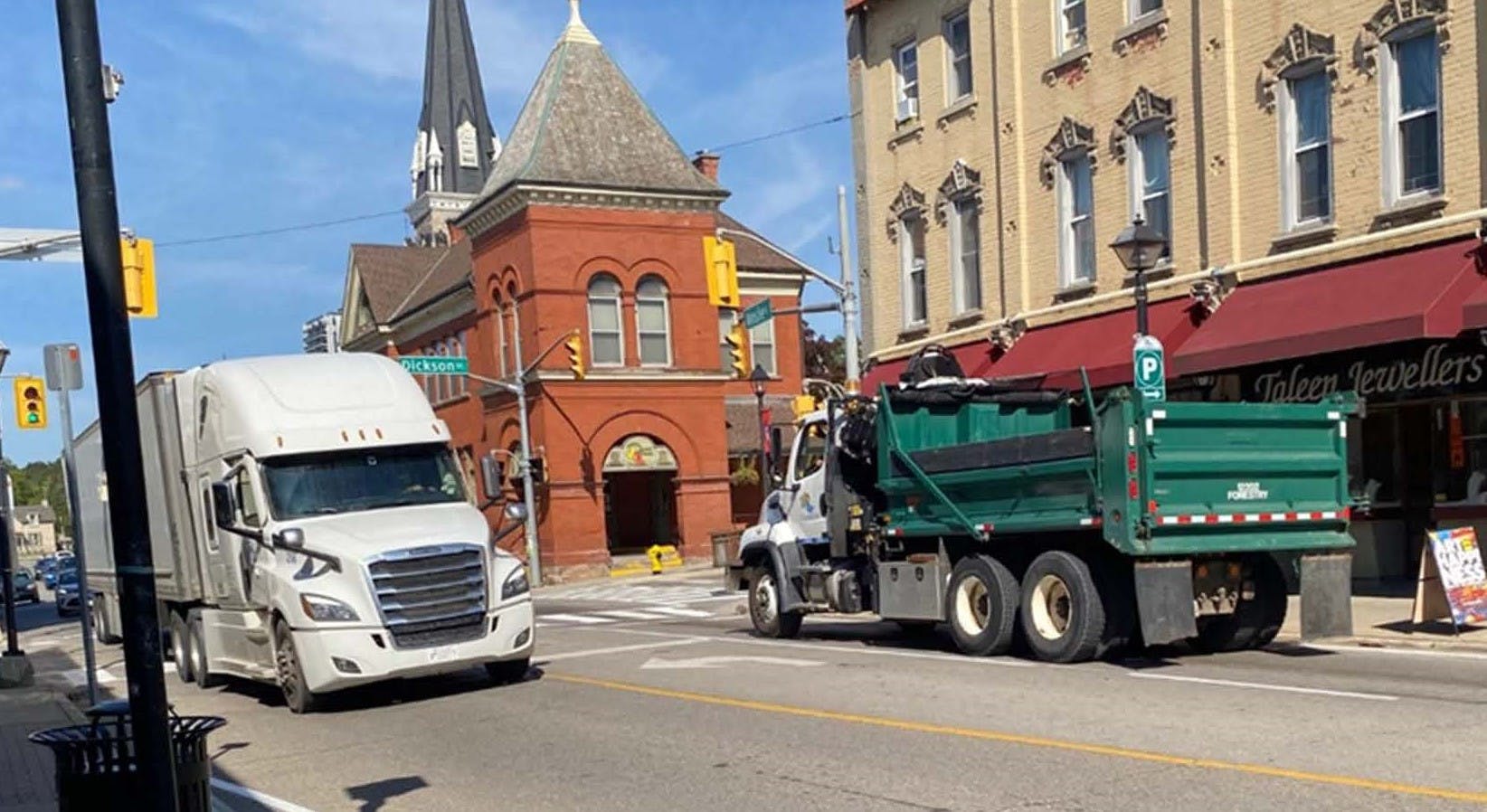FAQs
Why is the Region and the City of Cambridge considering diverting through trucks from downtown Cambridge?
Downtown streets were neither planned nor designed to accommodate large numbers of through vehicles and trucks. The current traffic environment hampers the development of a more vibrant, attractive, environmentally and socially sustainable, and financially successful downtown. Reducing the number of vehicles, especially large trucks has been planned for many years and it would allow the development of streets and land uses that are much more attractive to residents and visitors, and are supportive of the long term vision for downtown Cambridge.
Would trucks making deliveries in the downtown be banned?
No, trucks making deliveries in the downtown will continue to travel through Water and Ainslie streets.
How many trucks would remain on downtown streets with a diversion?
It is estimated that about 62 per cent (about 1000 trucks per day) of the existing truck volume would be diverted and the remaining 38 per cent (about 600 per day) would still travel to downtown to deliver to local businesses and residents. Essentially, the downtown truck ban would redistribute the truck volume to a wider network.
Would trucks be banned at specific times of day?
Through trucks would be banned at all times (24/7).
If trucks are banned from travelling through downtown, what are the alternate routes?
The major alternate routes would be MSB and Franklin Blvd.
What is the potential air quality impact of truck diversion from downtown streets to alternate routes?
The diversion of through trucks from downtown streets to alternate routes would not have a significant impact on the total number of trucks; however, it would re-distribute them on the transportation network.
The total distance of travel by trucks without the diversion is somewhat shorter, but travel is often in stop and go conditions due to the numerous signals, narrow corridors, and interactions with other street users. Emissions in these circumstances are higher than for vehicles travelling with fewer stops. As a result, the overall air pollution is estimated to be the same.
However, exposure to pollution is different. Downtown streets are typically narrower, buildings are closer to the road and the sources of pollution compared to the most impacted diversion routes (MSB and Franklin Blvd).
Will noise walls be built along the alternate truck corridors?
The installation of noise walls will follow the Regional Council’s Noise Policy.
What is the Region going to do to mitigate the noise of the additional trucks on the diversion routes?
Regional staff has estimated the likely increase of truck volumes on MSB, Franklin Blvd, Concession St, and Dundas St. The increase will be more significant along MSB and Franklin Blvd, and it is expected to be much less on Dundas St and Concession St. Based on the noise analysis so far, some sections on Franklin Blvd have met the warrants for noise walls even without the diversion and work is ongoing to install noise attenuation walls. Work is ongoing to identify which sections of MSB and Franklin Blvd will meet the warrants for noise walls if the truck diversion goes ahead.
When is McQueen Shaver Boulevard going to be extended to the east?
McQueen Shave Blvd is planned to be extended from Franklin Blvd to Dundas St in 2025-2026. The East boundary Rd is planned to be extended from Dundas St to Wesley St in 2025-2026.
When will we find out whether or not we will get a noise wall?
Without the diversion of trucks from downtown Cambridge, the Region’s Noise Policy does not call for noise walls along MSB . With the diversion of through trucks, the preliminary noise assessment shows that noise walls would be warranted for some sections along MSB. Further assessment and detailed design, to be completed in early 2023, will confirm the extent and locations of the noise walls.
Why wasn’t Concession/Main St. removed from the truck route network?
The Concession/Cedar St bridge is one of the very few bridges across Grand River, and Concession/Main St provides a relatively short connection to Franklin Blvd. Concession/Main St are Regional roads with a function to accommodate traffic including trucks as efficiently as possible. That is the reason why Concession/Main corridor is part of the truck route in the Region and City’s transportation network plan. Removing Concession/Main St from the truck rout network, and diverting trucks to MSB, would more than triple the distance from the Cedar St bridge to Dundas St.
Are there plans to limit the number of trucks on Myers Rd?
Myers Rd runs parallel to MSB and practically diverting trucks from Myers Rd to MSB is reasonable. This scenario would be analysed as part of the ongoing noise assessment.
Why isn’t the truck diversion delayed until the completion of MSB east of Franklin Blvd?
Franklin Blvd was built to accommodate trucks and with the currently built section of MSB, it provides a reasonable alternative to trucks travelling north and south.
Why is the truck restriction not limited to Water St only?
The truck numbers would increase significantly on Ainslie St and that would not support the Downtown Cambridge revitalization objective for Ainslie St.
How would the truck ban be enforced?
Staff is working on developing a signage plan that would be implemented if the diversion is approved. The signage will provide information, give directions to the truck drivers, and identify the prohibited and alternative routes. The effective enforcement of the truck ban along the restricted downtown streets is key to the success of this plan. Waterloo Regional Police Services will be part of the conversation moving forward

